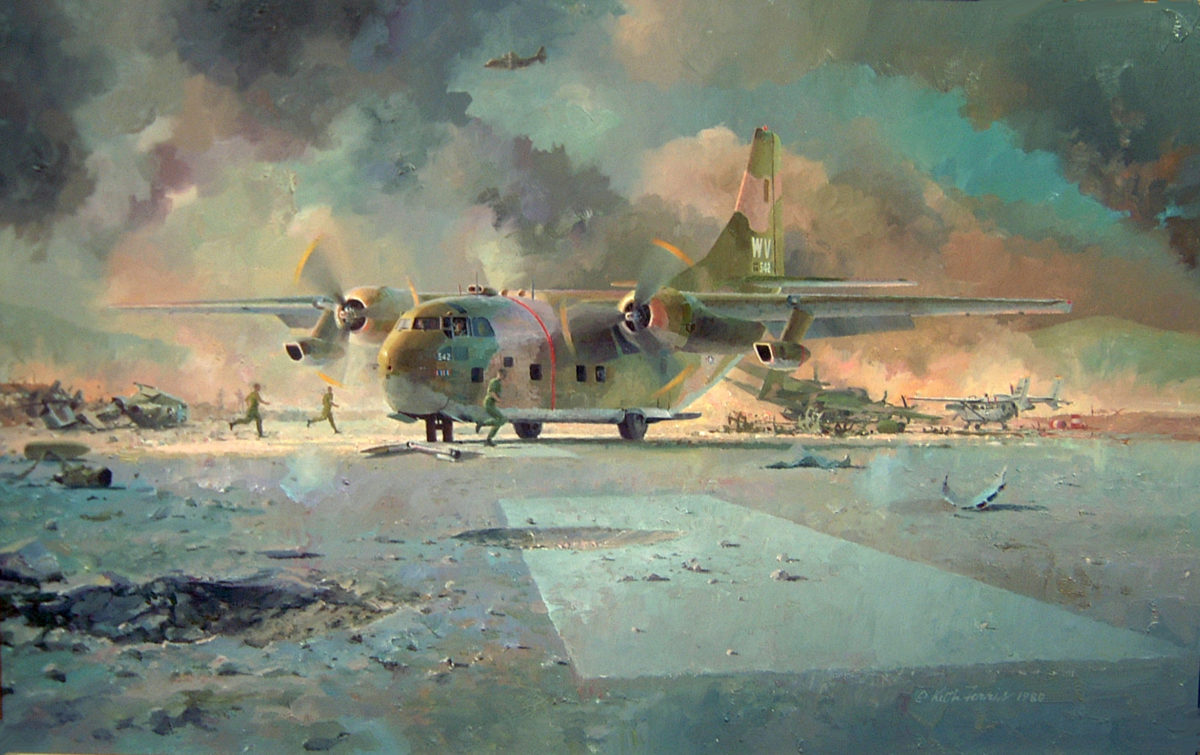These 10 great aerial rescues demonstrate that aircraft serve a far nobler purpose than hauling passengers and cargo or dealing death from the skies
Aircraft quickly became weapons of war, but less expected was their role as rescuers. Today it seems inevitable that aircraft—particularly helicopters—should be used as angels of mercy, to pluck the endangered from peril in ways that no other vehicle can. But it certainly wasn’t part of their job description originally. A few aerial rescues were performed during World War I almost as afterthoughts, and during the 1930s the U.S. Coast Guard developed amphibious aerial rescue techniques. It took the next world war, however, to create aircraft and procedures truly devoted to aerial rescue.
Now, many wars later, landplanes, seaplanes, STOL-craft and sophisticated fling-wings have extended the aerial-rescue operating theater to distances, altitudes and environmental conditions that were until recently unimaginable. And, as always, bravery has extended them even farther.
A Provider Provides an Out
Amid the wreckage of one of the U.S. Army’s worst defeats in Vietnam—the Battle of Kham Duc—acts of heroism shone, none more brightly than Lt. Col. Joe Jackson’s rescue of three otherwise-doomed American airmen. Kham Duc was an isolated Special Forces camp with a single short, narrow runway, and in May 1968 the base was overrun by the NVA. A thousand U.S. and South Vietnamese troops and many civilians were evacuated from the beleaguered strip by a stream of Air Commando C-123 Providers and C-130s. Their rescues included extracting the three-man Air Force combat control team (CCT) that had been on the ground coordinating the evacuation.
In a baffling display of desk-jockey stubbornness, Saigon ordered the CCT back into Kham Duc to finish their job, despite the fact that nearly everybody had already been evacuated. The team was back in Kham Duc just in time to hear the airborne command post declare the evacuation finished.
Fortunately, the C-130 crew that had emplaced them made it abundantly clear that three Americans were still on the ground. A C-123 landed to pick up the abandoned CCT, but mortar, rocket and machine-gun fire turned the landing into an immediate touch-and-go. (Eight aircraft had already been shot down or destroyed on the ground.) Colonel Jackson, also piloting a Provider, was next in line, and it never occurred to him to say the rescue was too risky. To give the North Vietnamese the least possible opportunity to target him, Jackson used what we’d today call a tactical approach and assault landing, diving from 9,000 feet with gear and flaps down, power at idle, and then touching down short and hard. The runway was blocked by a wrecked helo, allowing only 2,200 clear feet for takeoff, but the CCT scrambled aboard and Jackson was off moments later—as a 122mm rocket landed just 25 feet from the Provider’s nose, but thankfully didn’t explode. For his selfless heroism, Jackson was awarded the Medal of Honor.
The First of Many
Richard Bell-Davies became a Royal Naval Air Service pilot in 1913, at a time when British aviators were all hyphenated, peers or rich, sometimes all three: Bell-Davies had learned to fly three years earlier on his own dime. He is frequently credited with having been the world’s first carrier pilot, making the first takeoff and cable-arrested deck landing on an aircraft carrier while it was underway in September 1918. But he had already made history on November 19, 1915, by performing the world’s first rescue mission by an aircraft, a feat for which he earned the Victoria Cross.
Bell-Davies and Flight Sub-Lt. Gilbert Smylie had been flying a bombing mission against a Bulgarian railway junction that was crammed with supplies for the Turks fighting the British during Churchill’s Folly—the disastrous Dardanelles campaign. Smylie’s Farman bomber was hit by heavy fire and crash-landed in a rocky, dried-out marsh just inside the Bulgarian border with Turkey. Bell-Davies quickly decided to land and retrieve him, but his biggest concern was that Smylie might have also been carrying a bombardier/gunner. “An experienced gunner officer was much more valuable than a newly minted sub,” Bell-Davies wrote in his autobiography—and he knew he could only carry one passenger in his single-seat Nieuport. He didn’t dare consider how he could leave either man behind.
Smylie was alone, fortunately, and while a squad of Bulgarian troops pounded toward the airplane, Bell-Davies crammed Smylie into the Nieuport’s footwell, where the young sub crouched on all fours between the rudder bar and the firewall, hunkered under the oil tank for the 45-minute flight home. It reportedly took two hours to extricate Smylie from the various rods, cables and controls, but better that than spending the rest of the war in a Bulgarian prisoner of war camp.
Alaska Ranger
When I was a young merchant seaman, we called Coast Guardsmen “knee-deeps,” implying that they never got far from the safety of rivers and shores. There is no
greater refutation of that condescension than the Coast Guard’s rescue of 42 of 47 souls from the fishing ship Alaska Ranger in late March 2008, plucking the surviving men (and one woman) from the bitter-cold Bering Sea, which is plenty more than knee-deep. And doing much of it at night, amid 20-foot waves, 30-knot winds, -24 degree wind chill and snow showers. Twenty of the rescues were made by two Coast Guard helicopters: a Sikorsky HH-60 Jayhawk and a Eurocopter HH-65 Dolphin. The rest of the survivors were picked up by Alaska Ranger’s sister ship Alaska Warrior while a Coast Guard C-130 orbited overhead coordinating communications and searching for life vest strobes scattered amid a mile-long drift zone.
The helos were 120 miles from the nearest helipad. The big Jayhawk could do midair refueling by picking up a hose from the cutter Munro, which was steaming toward the sinking ship, and the Dolphin was able to land on the cutter, though with great difficulty on a severely pitching, rolling deck. During the rescue, the Dolphin landed aboard to drop off an overload of freezing fishermen with barely 20 gallons of jet fuel remaining—which, for a 1,700-hp aircraft, is little more than fumes.
Bravest of the brave were the Coastie rescue swimmers, who were dropped into the water to help survivors into lifting slings or baskets. One swimmer, on his first for-real rescue mission, was left in a life raft for an hour, after giving up his space on the helo to a hypothermic survivor.
PBY Maximum Effort
To land a PBY-5 Catalina in 16- to 18-foot Pacific seas is a feat of rare air- and seamanship. To do it four times in one day, under heavy enemy fire, is incomprehensible. Yet U.S. Navy Lt. j.g. Nathan G. Gordon did exactly that on February 15, 1944, to rescue 15 Army airmen within sight of furious Japanese machine gunners and artillerymen at Kavieng, north of New Britain.
Gordon had been flying night anti-shipping missions as part of VP-34, one of the notorious “Black Cat“ patrol squadrons, when he got a hurry-up call that an A-20
Havoc had been downed during a daytime raid on Kavieng. Gordon’s rescue mission was given an escort of four P-47 Thunderbolts, but his incredible landing between the big swells sweeping in toward the large Japanese base proved fruitless. There was wreckage and a raft but no sign of the Havoc’s crew.
After taking off, Gordon got a message from the crew of a B-25 Mitchell orbiting the area. They gave him the coordinates of a ditched Mitchell. Gordon quickly found it, landed again and took aboard six B-25 crewmen while under heavy fire. Fortunately, the swells were so deep that the Cat spent half its time bobbing out of sight of the Japanese shore gunners.
Another takeoff, another turn to a heading home. This time Gordon got about 20 miles before the same B-25 called with news of another ditched bomber about a mile from shore. Back Gordon went to pick up the three surviving crewmen. By this time, the Cat’s hull was leaking badly where rivets had popped during the full-stall, slow-as-possible landings, and two of his escorting P-47s had called bingo fuel and headed home.
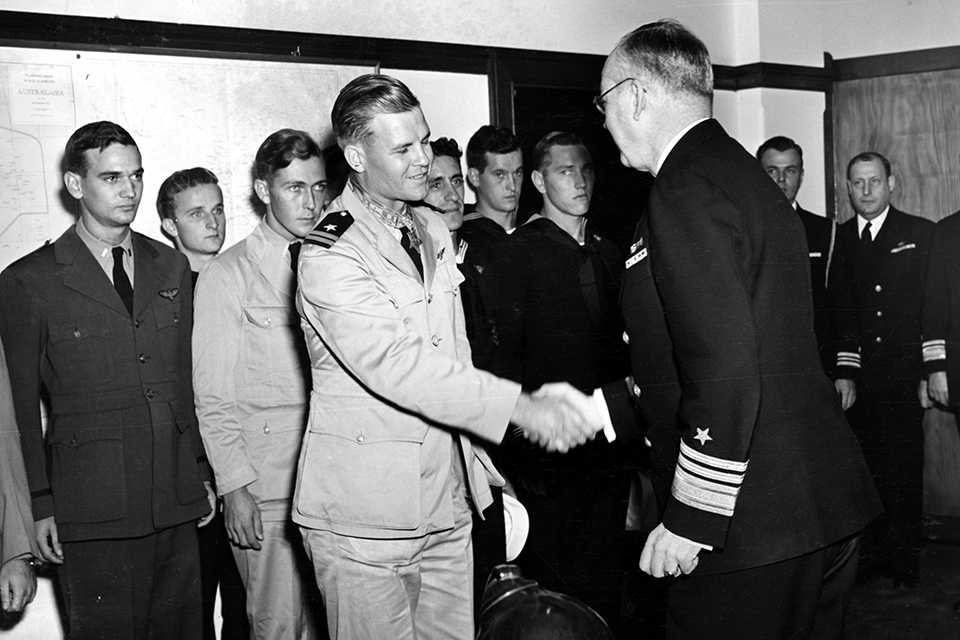
With nine extra passengers, several badly wounded, Gordon set off again for his base, but within minutes the radio crackled yet again. This time, the ditched B-25 was just 600 yards offshore. To land between the swells, Gordon had to make his approach directly over the Japanese guns and without the help of any suppressing fire; the last two P-47s had already left. He and his crew picked up six more bomber crewmen and finally were cleared to leave with their 15 extra passengers—an accomplishment for which Gordon was awarded the Medal of Honor and his entire crew Silver Stars.
Behind Enemy Lines
There was a time when the U.S. Air Force flew seaplanes—and none more successfully than the big Grumman SA-16 Albatross piloted by 1st Lt. John Najarian to make a rescue far behind enemy lines during the Korean War. Captain Kenneth Stewart had parachuted from his F-51D Mustang after running into flak 50 miles northeast of Pyongyang, the North Korean capital. Stewart came down in the narrow, shallow, debris-dotted Taedong River late on a June afternoon in 1951, fortunately with enough daylight left for his squadron mates to spot his collapsed chute and call for a rescue.
Najarian got the duty, but by the time he arrived on the scene it was dark and moonless. Najarian lined his amphibian up with a river he could barely see, under spray-and-pray gunfire from both of its banks, and made a steady 200-feet-per-minute letdown on instruments until he hit the water, with an airplane the width and weight of a PBY. (He had totally darkened the aircraft and didn’t dare use his landing lights, which would have been flak magnets.) With the help of orbiting F-51s, Najarian back-taxied to Stewart’s last known location and was able to pick him up when the Mustang pilot briefly flashed a light.
If the landing was hard, takeoff was harder. By this time, the downriver current had swept the Albatross toward a set of major power lines. With the North Korean gunners increasingly getting the range, Najarian had to take off immediately, again pretty much on instruments, toward the power lines. Fortunately, his F-51 escorts were aware of the cables and slow-flighted above him in trail, illuminating them with their landing lights as Najarian lifted off and held the big Grumman down until he’d passed under the wires.
It’s worth remembering that in this rescue as in many others, the airplane’s unsung crew members were risking their lives fully while they made the actual pickup. Najarian’s name is rightly remembered, but forgotten are the half dozen other airmen who were aboard that Grumman.
Gauli Glacier
On November 19, 1946, a U.S. Army Air Forces C-53 Skytrooper—the troop-carrying version of the cargo-configured C-47—crash-landed on the Gauli Glacier, in the Bernese Alps of central Switzerland. The twin-engine Douglas had been flying through bad weather, already too low among towering peaks, and a powerful downslope wind made the hard, wheels-up touchdown inevitable. When the transport was reported missing, an international full-court media press began, for it had been carrying a cargo of high-ranking officers, one of them a general, plus two wives, a 12-year-old daughter and the pilot’s mother—a dozen people in all, including four crew. Other than a crewman’s badly fractured leg, injuries were minor, but five frigid days and nights at nearly 11,000 feet in drifting snow left its occupants near the edge of survival.
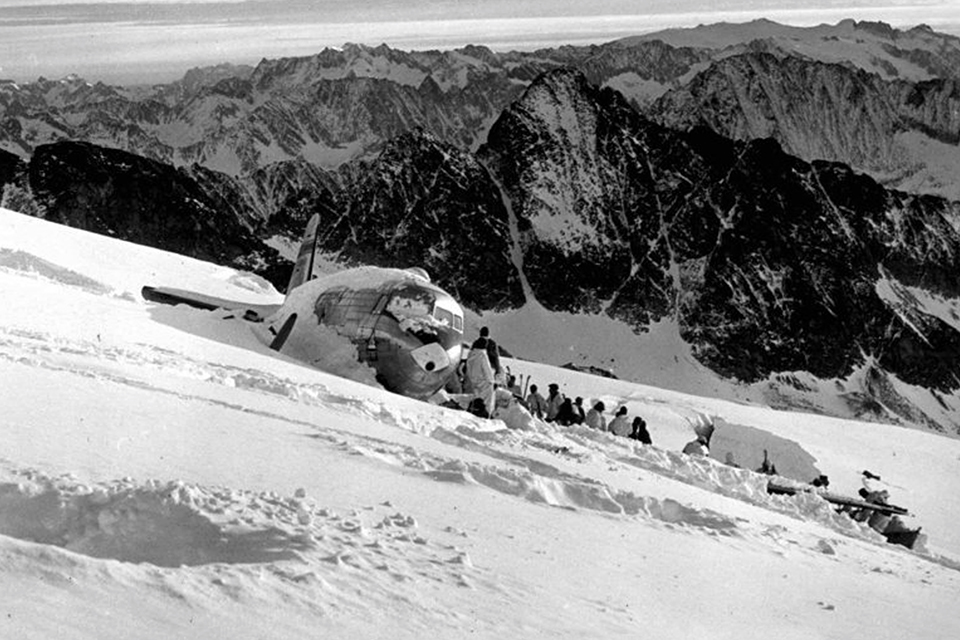
The U.S. Army had mounted a huge but pointless rescue mission involving two trainloads of jeeps, tracked M29 Weasels and 150 mountain troops. The Swiss pointed out that none of the vehicles or men would be of any use in the Alps, and themselves sent 80 experienced mountaineers toward the wreck site. It took the climbers 13 grueling hours to reach the C-53, and even the Swiss were of little use by that time.
Some 100 aircraft including B-17s, B-29s and RAF Lancasters (one of which was the first to spot the crash site) had been involved in the search and subsequent dropping of survival gear and food, much of which fell into ravines or deep snow, but the actual rescue was performed by two small, ski-equipped Swiss army Fieseler Fi-156 Storches. The stalky STOL planes carried everybody to safety during deteriorating weather, in eight flights from the glacier.
The Swiss had experimented with skiplanes and snow operations during WWII, but this was the first attempt at actual high-altitude glacier landings and takeoffs. The Gauli Glacier crash began a tradition of Swiss aerial mountain rescues that continues to this day.
Operation Halyard
The biggest behind-enemy-lines aerial extraction ever attempted—and pulled off—took place in Yugoslavia between August and December 1944. Numbers are difficult to confirm, since this was a controversial operation that remained classified until the late 1990s, but best estimates are that more than 500 American, British, Canadian, French, Italian and Soviet airmen who had crash-landed or parachuted after raids on Romanian oil facilities, including infamous Ploesti, were spirited out of German-held Yugoslavia by Douglas C-47s, from dirt strips and pastures that would have challenged a single-engine Cessna pilot.
The airmen and their Serbian protectors cleared the initial 2,100-foot runway using nothing but shovels, hoes, axes and oxcarts. On August 9, the first four Skytrains landed at night on a mountain strip they’d never seen, lit by burning hay bales, and flew out a dozen men per airplane. Every rescue flight for the next 4½ months had to go perfectly, lest the runway be blocked by a ground-looped C-47 or, worse, a fiery crash attracted German troops from a base barely 15 miles away.
The decision was quickly made to abandon suicidal night runs, so the unarmed C-47s had to risk daylight trips through skies patrolled by the Luftwaffe. This called for the best fighter escorts available—the Tuskegee Airmen of the 332nd Fighter Group, known for their propensity to stick with their charges rather than chase the Luftwaffe. When Wehrmacht activities made the initial runway unusable, Operation Halyard moved to first one, then another mountain strip. The rescues ended when the oil interdiction campaign wound down for lack of targets.
Hitching a Ride
In March 1966, 2,000 North Vietnamese regulars attacked a tiny Special Forces squad and several hundred South Vietnamese Civilian Irregular Defense Group soldiers at a camp in the A Shau Valley, near the Ho Chi Minh Trail. Under an 800-foot ceiling that obscured the tops of the surrounding hills, air support for the Green Berets was limited, but A-1 Skyraiders were still low and slow enough to harass the attackers. The NVA had surrounded the camp, however, and their guns controlled its narrow landing strip.
One of the strafing Spads was hit but managed to skid onto the 2,500-foot runway, its crushed belly tank erupting in flames. The pilot, Major Dafford Myers, ran into the underbrush alongside the strip. Major Bernard Fisher saw it all and immediately began coordinating rescue efforts. A helicopter was inbound from 30 minutes away, but NVA troops were just 200 yards from Myers, barely held back by the angry Skyraiders’ 20mm cannons.
Fisher knew what he needed to do, though everybody on the frequency warned him that he’d die trying. He landed on a runway cluttered with tire-shredding spent shrapnel and debris. Fisher was flying a “Fat Face” two-seat A-1E Skyraider, so at least he had room for Myers…if he could survive the landing, find his man and make the takeoff, all under direct fire.
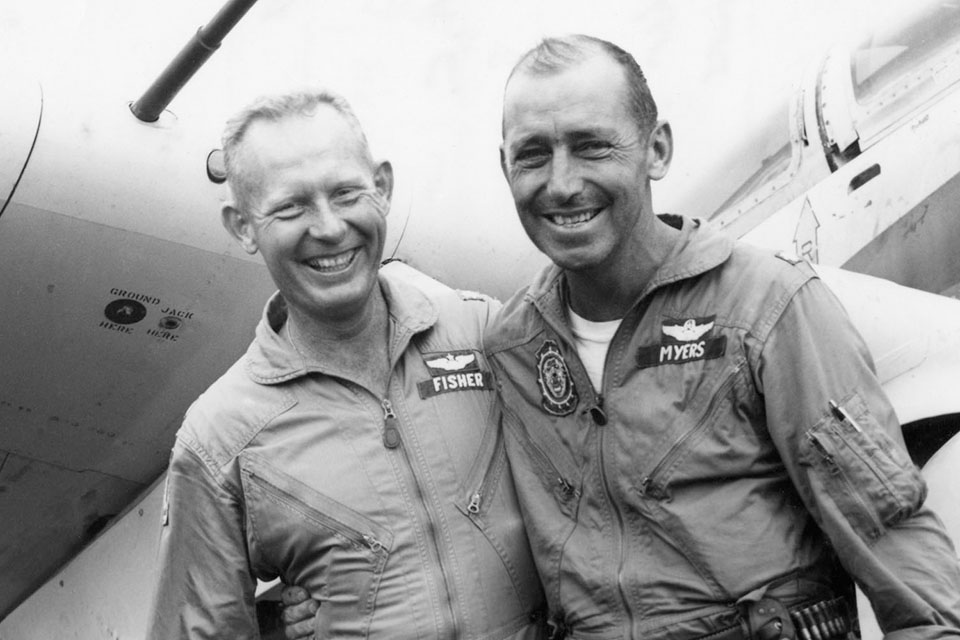
Bernie Fisher’s Spad took 19 hits, but he pulled an exhausted Myers aboard and firewalled the throttle. “You are one crazy sonofabitch,” Myers said.
In a strange coincidence, a similar rescue had taken place during WWII, when Captain Richard Willsie’s P-38J Lightning was shot down during an August 1944 raid on the Ploesti oil refineries. Willsie was rescued by Flight Officer Richard Andrews, who landed his own P-38 next to Willsie’s downed airplane and pulled him aboard, somehow making room for his cohort in the single-seat cockpit.
Two decades later, Willsie was the commander of Dafford Myers’ squadron, and Andrews flew a Skyraider that provided supporting fire during Myers’ rescue.
Prinsendam Afire
MV Prinsendam was a Dutch liner that specialized in Pacific cruises for the wealthy elderly. The ship was not a floating housing project like today’s Caribbean cruisers but a relatively intimate 427-foot luxury yacht. Yet all its pretensions couldn’t keep a fuel line from bursting and spraying fuel onto one of the ship’s four 4,000-hp diesel engines. It happened at midnight on October 4, 1980, in the Gulf of Alaska, one of the most inhospitable bodies of water in the world. Within hours the fire was out of control, and a combination of airways and natural chimneys quickly spread superheated flames and choking smoke throughout the ship.
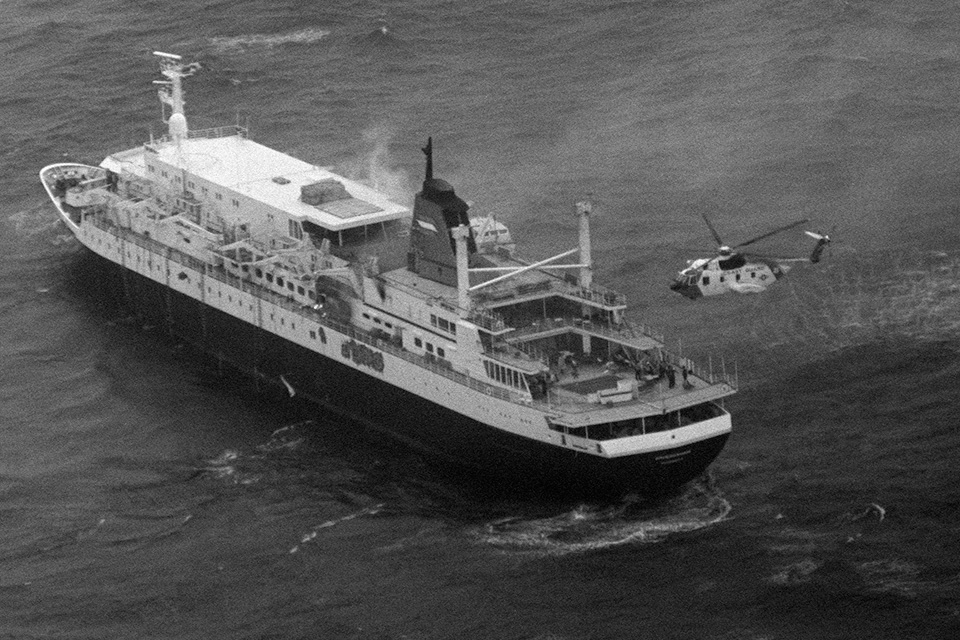
So began the largest peacetime air-sea rescue the world has yet seen: 320 passengers and 200 crew, most of the passengers over 65, some of them in wheelchairs and walkers, were cast adrift in the middle of the night in lifeboats on a frigid, angry sea. The weather was worsening as a typhoon moved into the area, land was 150 miles away, the nearest U.S. Coast Guard cutter 10 hours distant. It was up to the Coast Guard to coordinate a long-distance rescue that involved a fleet of Coast Guard, U.S. Air Force and Royal Canadian Air Force helicopters and C-130s, Air Force parajumpers, three Coast Guard cutters, the supertanker Williamsburgh and a host of support vessels.
One Coast Guard helo dropped a firefighter and a powerful pump onto Prinsendam’s deck to help a skeleton crew that had stayed aboard, but the effort failed. When Williamsburgh hove to near the sinking Prinsendam, the supertanker became the focus of the rescue effort. Barely a hundred feet shorter than a nuclear carrier, Williamsburgh had two large helipads and room for Prinsendam’s entire complement, but few could climb the rope ladders to its deck. Throughout the day, hurrying to get everybody aboard before dark, helicopters transferred survivors from lifeboats to Williamsburgh, flying in strong winds and, at times, 25-foot seas.
By nightfall, the rescue was declared over…but it wasn’t. “Where are my PJs [parajumpers]?” the commander of USAF operations cabled the Coast Guard. They were aboard a single forgotten lifeboat, which was finally located at 2:30 the next morning and its 22 occupants transferred to the cutter Boutwell. Not a man, woman or child had been lost.
Mountain High
The unofficial world altitude record for helicopters is exactly 42,500 feet, set in March 2002 by cinema pilot Fred North in an altitude-optimized Aérospatiale AS-350B2. But there’s a difference between forcing a totally stripped, single-pilot turbine helo to a height so extreme that its engine flamed out as soon as it got there, and flying to the rescue of a Himalayan climber. Looming mountain crags, swirling clouds, turbulence and helicopter aerodynamics confuse the issue. The record for a mountain rescue, performed in May 2013 by Italian pilot Maurizio Folini in an AS-350B3 on Lhotse, near Mt. Everest, stands at 23,590 feet.
A helicopter at extreme altitude—which for conventional small helos means pretty much anything over 10,000 feet on a warm day—is a touchy beast. For Folini’s rescue of a Nepalese-Canadian armless double-amputee climber, a Sherpa on the ground had to clip that client onto the end of a 65-foot line dangling beneath the helicopter, in a situation where, as Folini said in an interview following a different and ultimately unsuccessful rescue attempt, “A bag of groceries clipped to the longline would have brought [the helicopter] down.”
Client? Yes, unlike most other aerial saves, Himalayan rescues are business arrangements, not humanitarian endeavors. A typical rescue mission costs $2,500 an hour and can consume at least three hours of helo time, so life-saving flights and the accompanying tourist and sightseeing trips have become a controversial trade in the Himalayas, with a number of Italian, Swiss and Nepali companies competing for the business.
For further reading, contributing editor Stephan Wilkinson suggests: The Forgotten 500: The Untold Story of the Men Who Risked All for the Greatest Rescue Mission of World War II, by Gregory A. Freeman; Burning Cold: The Cruise Ship Prinsendam and the Greatest Sea Rescue of All Time, by H. Paul Jeffers; and Deadliest Sea: The Untold Story Behind the Greatest Rescue in Coast Guard History, by Kalee Thompson.
This feature originally appeared in the January 2016 issue of Aviation History Magazine. For more great articles, subscribe here!

